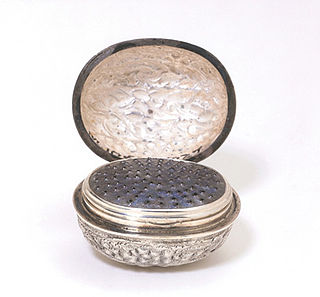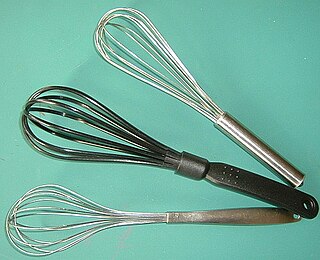 W
WA bar spoon is a long-handled spoon used in bartending for mixing and layering of both alcoholic and non-alcoholic mixed drinks. Its length ensures that it can reach the bottom of the tallest jug or tumbler to mix ingredients directly in the glass.
 W
WA beer engine is a device for pumping beer from a cask, usually located in a pub's cellar.
 W
WA beer tower is a beer dispensing device, sometimes found in bars, pubs and restaurants. The idea behind beer towers is that several patrons in a group can serve themselves the amount of beer they want without having to order individually.
 W
WA blender is a kitchen and laboratory appliance used to mix, crush, purée or emulsify food and other substances. A stationary blender consists of a blender container with a rotating metal blade at the bottom, powered by an electric motor that is in the base. Some powerful models can also crush ice and other frozen foods. The newer immersion blender configuration has a motor on top connected by a shaft to a rotating blade at the bottom, which can be used with any container.
 W
WA chinois is a conical sieve with an extremely fine mesh. It is used to strain custards, purees, soups, and sauces, producing a very smooth texture. It can also be used to dust food with a fine layer of powdered ingredient.
 W
WA cocktail shaker is a device used to mix beverages by shaking. When ice is put in the shaker this allows for a quicker cooling of the drink before serving.
 W
WA cocktail strainer is a metal bar accessory used to remove ice from a mixed drink as it is poured into the serving glass. A type of sieve, the strainer is placed over the mouth of the glass or shaker in which the beverage was prepared; small holes in the device allow only liquids to pass as the beverage is poured.
 W
WA corkscrew is a tool for drawing corks from wine bottles and other household bottles that may be sealed with corks. In its traditional form, a corkscrew simply consists of a pointed metallic helix attached to a handle, which the user screws into the cork and pulls to extract it. Corkscrews are necessary because corks themselves, being small and smooth, are difficult to grip and remove, particularly when inserted fully into an inflexible glass bottle. More recent styles of corkscrew incorporate various systems of levers that further increase the amount of force that can be applied outwards upon the cork, making easier the extraction of difficult corks.
 W
WA coaster, drink coaster, beverage coaster, or beermat is an item used to rest drinks upon. Coasters protect the surface of a table or any other surface where the user might place a drink. Coasters placed on top of a beverage can also be used to show that a drink is not finished or to prevent contamination. Coasters can also stop hot drinks from burning the table surface.
 W
WAn ice cube is a small piece of ice, which is typically rectangular as viewed from above and trapezoidal as viewed from the side. Ice cubes are products of mechanical refrigeration and are usually produced to cool beverages. They may be produced at home in a freezer with an ice tray or in an automated ice-making accessory. They may also be produced industrially and sold commercially.
 W
WA shot glass is a glass originally designed to hold or measure spirits or liquor, which is either imbibed straight from the glass or poured into a cocktail. An alcoholic beverage served in a shot glass and typically consumed quickly, in one gulp, may also be known as a "shooter".
 W
WA juicer, also known as a juice extractor, is a tool used to extract juice from fruits, herbs, leafy greens and other types of vegetables in a process called juicing. It crushes, grinds, and/or squeezes the juice out of the pulp.
 W
WA loggerhead is a type of tool consisting of a ball or bulb which would be heated up attached to a long handle. Used to heat or melt solids and solidified liquids, it was formerly a fairly common tool. For example, loggerheads were used by shipbuilders to melt pitch. Although not its intended purpose, it was also used in American taverns in the 17th and 18th centuries in the making of the then popular mixed drink flip.
 W
WThe Magic Bullet is a compact blender sold by Homeland Housewares, a division of the American company Alchemy Worldwide, and sold in over 50 countries. It is widely marketed through television advertisements and infomercials and sold in retail stores under the "As seen on TV" banner. A feature-limited retail version not under this banner called the "Magic Bullet Single Shot+" is also available.
 W
WA margarita machine is a margarita dispensing device invented by Mariano Martinez in 1971.
 W
WMelon ballers are utensils to make balls of melon from a scoop with a diameter from around 1 centimeter to 3 centimeters. They are generally used to make fruit salad.
 W
WA mounted or bar corkscrew is a device screwed or clamped to a wall or counter top, used to draw corks from beer, wine or other bottles.
 W
WA nutmeg grater, or nutmeg rasp, is a device used to grate a nutmeg seed. Nutmeg graters are normally metal, cylindrical or half-cylindrical, the surface perforated with small rasped holes. The nutmeg is passed over the surface to grate. The grater may be combined with a compartment for storing the nutmeg seed between uses.
 W
WA swizzle stick is a small stick used to stir drinks. The original swizzle sticks were created in the 18th century at a rum plantation in the West Indies using the branch of the Quararibea turbinata. In the late 19th and early 20th centuries, stir sticks made of glass were created to shake out the bubbles from champagne, whose carbonation caused indigestion for some drinkers.
 W
WA whisk is a cooking utensil which can be used to blend ingredients smooth or to incorporate air into a mixture, in a process known as whisking or whipping. Most whisks consist of a long, narrow handle with a series of wire loops joined at the end. The loops can have different shapes depending on a whisk's intended functions. The wires are usually metal, but some are plastic for use with nonstick cookware. Whisks are also made from bamboo.
 W
WA zester is a kitchen utensil for obtaining zest from lemons and other citrus fruit. A kitchen zester is approximately four inches (100 mm) long, with a handle and a curved metal end, the top of which is perforated with a row of round holes with sharpened rims. To operate, the zester is pressed with moderate force against the fruit and drawn across its peel. The rims cut the zest from the pith underneath. The zest is cut into ribbons, one drawn through each hole.